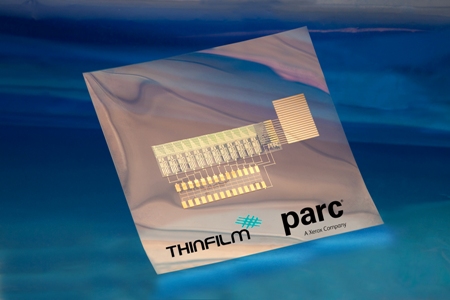Thin Film Electronics and PARC, a division of Xerox, have jointly developed a working model of a first-of-a-kind scalable, printed non-volatile memory device having organic circuits, the organic counterpart of CMOS circuitry.
Thinfilm Addressable Memory comprises transistors of PARC and printed memory of Thin Film Electronics. This development is an important landmark in the volume production of low-power, economical ubiquitous devices, which is a major component of the ‘Internet of things.’ The working model will be displayed on 24 October 2011 at PARC.
 Thinfilm Addressable Memory Prototype
Thinfilm Addressable Memory Prototype
Thinfilm Addressable Memory uses complementary pairs of p-type and n-type transistors to couple the transistor technology of PARC and polymer-based memory technology of Thin Film Electronics to build the circuits. The incorporation of integrated circuits produces the Thinfilm Addressable Memory by printable logic using roll-to-roll printing.
The development of Thinfilm’s Addressable Memory is one step closer to the realization of a world based on the ‘Internet of things,’ where all is connected through a smart tag. These smart tags need the commercial accessibility of devices that have rewritable memory and are economical and eco-friendly. These devices must be compatible with sensors and other electronic parts and can be mass produced using roll-to-roll printing. The new prototype with logic circuitry and rewritable memory will fulfill all of these needs.
The novel, non-volatile, ferroelectric, polymer memory technology of Thin Film Electronics is advantageous to these systems, since power consumption is minimal and external power connection is not needed to keep information. Thinfilm Addressable Memory system products such as near field communication (NFC) tags that are now present in Android phones allow equipment to equipment communication. These systems can also be used in disposable price labels and sensor tags.
The addressable memory in combination with other printed components, including sensors and antennas, can produce completely printed systems for communication with daily objects and the ‘Internet of things,’ where temperature monitoring of drugs and food or other retail items can be performed individually instead of by truckload, container or pallet using a NFC-enabled phone.